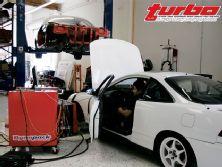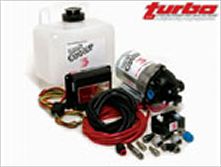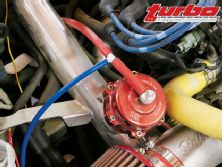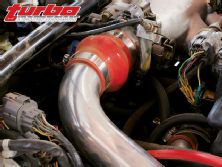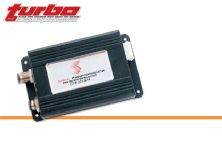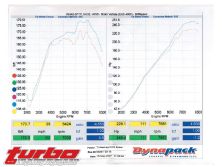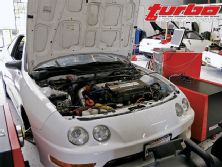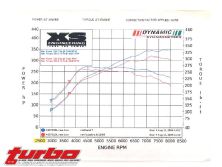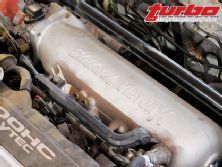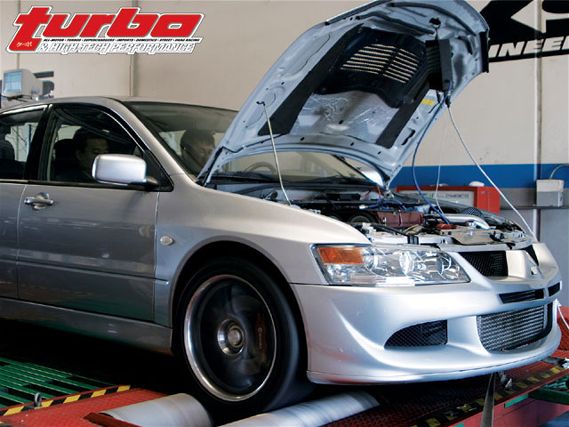 | Snow Performance Boost Cooler - Chemical Cooling
| Snow Performance Boost Cooler - Chemical Cooling
Detonation happens, and there's more than one reason why. ignition timing will do it. When spark timing is advanced too much, combustion chamber pressures can rise too high at the wrong time, resulting in minor explosions or pinging sounds we know as pre-ignition or detonation. It's like taking a hammer and whacking the tops of your pistons. Really hard. Low-octane gasoline will cause it too. Low-octane fuel burns faster than high-octane fuel, which can also result in too much chamber pressure given the right advanced spark, high-boost or high-compression circumstances. Lean air/fuel conditions, high engine temperatures and obstructions in the combustion chamber that act as hot spots will also lead to detonation. Detonation can make itself known through catastrophic engine damage, often times leaving sizeable peepholes in engine blocks or it can rear its damaging nature slowly, over time. Light detonation will gradually weaken pistons and piston rings, eventually causing them to fail. There's a fine line between the point at which an engine peaks horsepower-wise and the point at which rod bearings are smashed and pistons collapse. This dance along the ragged edge of detonation is what we call tuning. But while things like advanced ignition timing and leaner air/fuel conditions can cause detonation, they're also necessary when tuning for big horsepower.
Turbocharged engines typically exhibit much hotter intake temperatures in comparison to their naturally aspirated counterparts since the incoming air goes through a squishing process. Turbocharged combustion temperatures can also be much hotter. As boost levels increase, this only gets worse. Most turbocharged engines ward off the heat, which leads to detonation, by using an intercooler. Intercoolers, whether the air-to-air type or liquid-to-air type, drop the temperatures of the incoming air charge exiting the turbo's compressor before it enters the intake manifold. But intercoolers can only do so much and also have their negative side effects. As air travels through this heat exchanging process, it experiences a pressure drop; this is typically between 1 to 4 psi. And depending on the intercooler piping's shape, diameter and route taken, further restrictions are often placed on the intake charge. Besides, fitting an intercooler large enough for some particularly high-boost applications can often be impossible based on space constraints and weight factors.
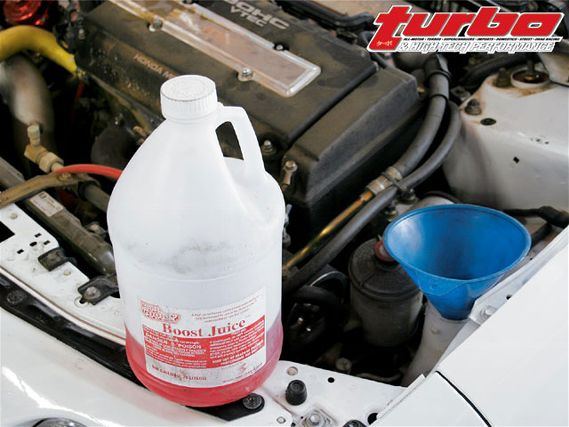 | Snow Performance Boost Cooler - Chemical Cooling
| Snow Performance Boost Cooler - Chemical Cooling
Another way to ward off detonation is to increase the fuel supply through larger injectors or a higher volume pump. This works, and needs to be done, to the extent that air/fuel ratios are corrected. But a diminishing point is often reached, where fuel ends up being used to cool things off in the chamber rather than for combustion. At this point the risk of piston ring wear is fairly high and an alternative cooling method is in order. Too much fuel can also slow down the burn process, making for a relatively safe, but not so powerful engine.
Snow Performance's Boost Cooler takes intercooling to another level, chemically. The system injects a mixture of water and methanol into the intake tract and ultimately into the combustion chamber along with the existing air/fuel mixture. The added water and methanol cools the intake charge even more, making it denser, which means increased air volume and more power. Water has a high latent heat of vaporization, which means it can absorb heat better than almost anything else, including conventional intercoolers. But chemical injection doesn't just cool things down. The recommended water/methanol mixture takes the cooling process one step further by chemically increasing the existing fuel's octane rating. The higher octane mix allows for a slower burn in the chamber, which is the reason why additional ignition timing can be applied. That's the beauty of methanol, since it's a high-octane fuel itself, it will typically net about 20 octane points higher when mixed with regular pump gas. Even though methanol has such a high octane rating, it only has about half the energy content as gasoline does, meaning you'll use twice as much when used alone. But the Boost Cooler doesn't use straight methanol. It works best with a 51/49 water/methanol mix along with any vehicle's regular dosage of pump gas. At this rate, a two-quart reservoir will last the average 500hp car roughly 15 passes down the quarter mile. On the street this will last significantly longer.
The first thing you have to come to terms " with before installing any water or methanol injection kit is the fact that liquid injection by itself won't really get you any more horsepower. At first. When water is injected into the intake stream and sent to the combustion chamber as a vapor, it doesn't burn. It simply converts into a gaseous state and exits through the exhaust. During its state change the water absorbs much of the heat in the combustion chamber, lowering overall temperatures. The water occupies space that would otherwise be used for the air/fuel mixture, in turn, lowering temperatures but at the expense of some power since there's now less air and fuel in the chamber. As a side benefit, water also has a sort of cleaning effect inside the chamber, over time helping rid the area of potential hotspots and carbon buildup on valves, piston tops and the chamber itself. When methanol is injected into the intake stream though, it's also sent to the combustion chamber but, unlike water, it burns along with the existing mixture of gasoline. The addition of methanol makes for a much richer air/fuel mixture. Too rich really, and it's easy to actually lose a little power at first. In order to take full advantage of what methanol injection has to offer, things need to be leaned out. So without some sort of fuel controller, the benefits of methanol injection might be missed. It's possible to run a slightly leaner air/fuel mixture when using methanol than without. This is where the extra power from methanol injection starts to show up. This and the fact that more ignition timing can be applied are attributed to methanol injection's octane increasing effect. In some cases the addition of methanol has allowed ignition timing increases normally only associated with 118 octane, and this is with pump gas. This is because methanol actually burns slower than gasoline. It also has a much cooler flame front. And when combined with water, methanol also helps lower intake temperatures well over 100-degrees Fahrenheit. All of this is good when you're looking for safe horsepower increases.
A good water/methanol injection kit consists of more than just a pump, container and some sort of on/off switch. The method by which the water or methanol is injected will significantly impact engine performance. Snow Performance's Boost Cooler takes this into account. We recently had the opportunity to test Snow's Boost Cooler on two vehicles: Project Integra and a mildly modified EVO VIII. Both vehicles already have AEM EMS systems and near-stock internals. What does this mean? It means both cars have the means to produce some serious power, but with stock internals, neither has any room for error. Snow's Boost Cooler kit is fairly simple. Its major components consist of a 150psi pump, a controller and a reservoir. Various fittings, electrical parts and specially designed nozzles are also packaged in the kit. The nozzles are important and can make or break an otherwise decent injection system as they determine the spray pattern the fluid will take. The nozzles included with the Boost Cooler kit are designed to spin the fluid supersonically and feature a venturi-shaped orifice that improves atomization. A high-flow pump is also important. In order to atomize properly and not puddle up in the intake manifold, the methanol mixture needs to be injected with at least 50psi behind it. Less pressure will result in decreased cooling since the liquid mixture remains confined to smaller areas unlike when it's spread apart through proper atomization. Snow's kit relies on boost pressure to determine the proper amount and when the water/methanol enters the intake stream. The kit's digital variable controller can be programmed to proportionally add fluid according to the rate of boost increase. This ensures the mixture won't be wasted under part-throttle and low boost conditions that don't need these same anti-detonation measures.
On both of our test vehicles we took advantage of the ability to increase ignition timing; that's how we were able to get the power increases we did. Honda's B18C1 already has fairly high base ignition timing and a rather aggressive curve suited for the naturally aspirated mill that it is. Even so, with the Boost Cooler activated we were able to put an additional eight degrees of total ignition timing on top of our previous, more conservative tune and lean out the air/fuel mixture slightly at the same time without any indication of knocking. This translated into seven percent more horsepower and five percent more torque upwards of the 4,000-rpm zone. This newfound torque was especially noticeable. In fact, there wasn't any area inside the Integra's power curve where we didn't see some type of power increase from our methanol mix. The results were slightly more impressive when it came to the EVO. Here we were able to increase total ignition timing by a factor of 12 degrees, which translated into a peak horsepower increase of more than 31 hp and almost 10 lb-ft torque. Like Project Integra, there are gains of at least 5 hp from just after 4,000 rpm onward. Both of these tunes were fairly conservative, suited for the street cars that they are. In either case, timing could have been increased for even more midrange and top-end power.
Water and methanol injection isn't really anything new; its uses date back to World War II. But it's not one of the most common upgrades you'll find on most high-performance engines. It should be though. Look at it this way: a Snow Performance Boost Cooler kit costs less than a typical intercooler setup. For that small investment, we were able to increase our EVO's power output by nearly 10 percent - a pretty remarkable number given the cost and tuning time - yet despite the additional horsepower, we ended up with a safer tune, even more resistant to detonation than what we had before. They say you can't put a price on safety, but you can. It's just under $400.

